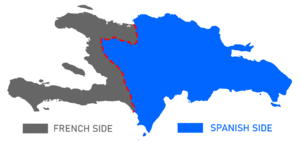Treaty of Aranjuez (1777) facts for kids
The Treaty of Aranjuez was an important agreement signed on 3 June 1777 between France and Spain. These two countries agreed to clearly define the border of their colonies on the island of Santo Domingo, which is also known as Hispaniola. This island is located in the Caribbean Sea.
Before this treaty, France and Spain both owned parts of Hispaniola, but the exact line dividing their lands wasn't always clear. The treaty helped them draw a fixed border from one side of the island to the other. Spain gained some land in the middle part of the island, in an area called the upper Artibonite Valley. The new border was marked with special border stones. The treaty was signed at the Aranjuez Palace, which is near Madrid in Spain.
It's important not to confuse this treaty with another one signed at the same palace in 1779. That later treaty, the Treaty of Aranjuez of 1779, led to Spain joining the American War of Independence.
How the Border Changed
The northern and southernmost parts of the border between Haiti and the Dominican Republic today still follow the lines agreed upon in the 1777 Treaty of Aranjuez. However, in the 20th century, the middle part of the border was changed. It was made straighter, running more directly from north to south. This change meant that a large part of Hispaniola that was once part of the Dominican Republic became part of Haiti. You can see one of the original border stones from the treaty on display at the Museo de las Casas Reales in Santo Domingo.
See also
- List of treaties
 In Spanish: Tratado de Aranjuez (1777) para niños
In Spanish: Tratado de Aranjuez (1777) para niños


